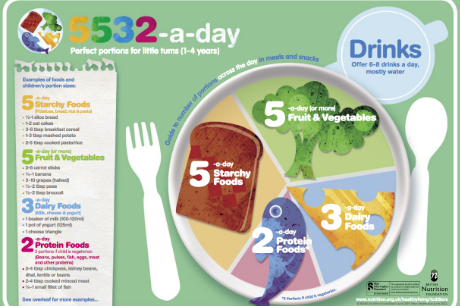
The British Nutrition Foundation (BNF) has published its updated 5532 guide, a resource about portion size and healthy eating for children aged between one and four.
The updated resource, developed by the BNF’s team of nutrition scientists and an advisory group of experts in early years nutrition, includes new information on free sugars and advice on vegetarian and vegan diets.
Its name comes from the number of portions of each food group children are advised to eat, which are:
- 5 portions of starchy foods
- 5 (or more) portions of fruit and vegetables
- 3 portions of dairy foods
- 2 portions of protein foods (or three if a child is vegetarian)

The 5532 guide also contains examples of foods within each group, portion size ranges to suit varying appetites, advice on breastfeeding and updated information on free sugars.
The resource addresses confusion on the nutritional value of fruit juice, stating that it ‘provides some nutrients but is also high in sugar and is acidic so, if consumed, should be diluted and kept to mealtimes.’
Sara Stanner, science director at the BNF, said, ‘The latest updates to our 5532 guide help to address some of the biggest causes of confusion around nutrition for little ones. We know that many parents are very concerned about sugar, and our guide highlights that sugary drinks and sugary treats like biscuits, chocolate and sweets shouldn’t be a regular part of children’s diets.
'It’s a good idea to check food labels and to look for lower sugar options when choosing foods like breakfast cereals or yogurts. Likewise, families making the decision to adopt vegetarian or vegan diets need to be aware of how to balance their diet, and use supplements if needed in order to ensure children get all the nutrients they need to be healthy.’
Other tips in the 5532 guide include:
Meal times: Try to have regular meal and snack times each day
Snacking: Offer children a small, healthy snack like fruit, vegetable sticks or toast fingers with cream cheese two to three times a day
Variety: Children’s food preferences vary from day to day so keep offering children new foods alongside familiar favourites
Appetite: Most young children can regulate their own appetite so encourage them to eat but don’t force them or expect them to eat if they are not hungry
Milk: Milk is a good choice for drinks as it provides calcium and other important nutrients. Children aged between one and two should have whole milk, which is a good source of vitamin A. Those eating well can be given semi-skimmed milk after two years. Skimmed or 1 per cent milk is not suitable as a main drink for children under five.
Salt: Limit the amount of salty foods children eat. They should eat no more than 2g of salt per day – a packet of crisps contains around 0.3g of salt, a slice of ham contains 0.3g, and 2 tbsp of standard baked beans contains around 0.5g.
Physical activity: Encourage children to be physically active for at least three hours over the day.
Ms Stanner added, ‘Establishing healthy eating habits from a young age helps to set a child up for good health later in life. Even when parents know which foods are part of a healthy diet, it can sometimes be difficult to know what sized portion is suitable for a young child, and how often they should be eating from the different food groups each day.’
- The 5532 resources are free to download here and printed copies are also available from the BNF shop.









